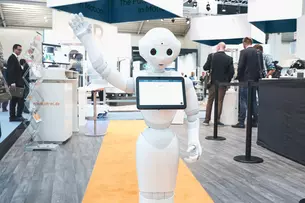“Data are the key”
Marco Huber, Professor of Cognitive Production Systems at the University of Stuttgart and Head of the Center for Cyber Cognitive Intelligence (CCI) at Fraunhofer IPA, revealed tips and tricks for getting into the topic “Machine learning for production”.
When is it worthwhile for a medium-sized company to enter the topic of artificial intelligence (AI) if you have not yet done anything with machine learning?
Huber: Getting started is worthwhile where the greatest benefit or possible value for a company is. As usual, time, quality and money count. In other words, can I optimize my production and achieve higher overall equipment effectiveness (OEE)? Does the product quality improve and do I have less scrap? And finally, the most important question: Does machine learning open up new business models for me? Especially in the last point, I believe that German SMEs still need to catch up, especially in comparison with the USA.
And where is the easiest place to start?
Huber: The easiest way to get started is where production machines are already networked and there is easy access to a lot of data, because data are the key to machine learning. By the way, before you deal too much with the concept, I suggest you just start. Otherwise, there is a risk that a competitor will be faster.
And what do you recommend doing to get started?
Huber: First of all, it is important to find suitable use cases in the company, but this is usually not very difficult. Then benefits and difficulty should be assessed, in other words, what data, expertise and technology do I need and what goals will I pursue with machine learning? And then I recommend four golden rules.
And they were?
Huber: First: Start small, think big. You should first work on individual process steps, because small progress already provides initial knowledge of machine learning and strengthen confidence in the technology. Second: Start early. If you identify useful use cases at an early stage and use short development cycles, you can quickly get initial prototypes. Third: Pay attention to the benefits. A project for machine learning ultimately stands or falls with that. My advice to decision-makers: let the specialist department push the subject forward, not IT. And fourth: Involve everyone. You should not forget the employees in machine-learning projects. Convincing them of the benefits of the project will prevent unnecessary blockages.
What is being researched?
According to Professor Marco Huber, deep learning is currently an important topic in research on machine learning. For example, this includes reinforcement learning. Prof. Huber: “One example would be a robot that is no longer programmed, but learns its activity using an algorithm based on the trial and error principle.” On the other hand, transfer learning is about transferring experiences and knowledge from what had been learned to similar tasks, so as not to have to start all over again. Prof. Huber: “And, of course, the researchers also deal with meta-learning, that is, learning how you learn.”

